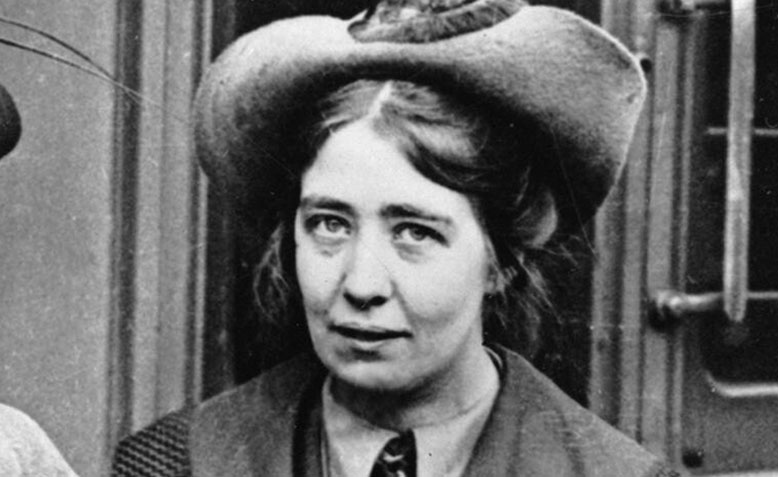 Sylvia Pankhurst. Photo: Wikimedia Commons
Sylvia Pankhurst. Photo: Wikimedia Commons
Jacqueline Mulhallen reflects on the radicals who helped reshape global democracy
It is 100 years since some women were granted the vote. The media is mostly celebrating Emmeline Pankhurst and her daughter Christabel, and giving the impression that the vote was won by elegantly dressed well off women in London. But how true is this?
The Pankhurst family were from Manchester, where there was a strong history of campaigning for votes for women. Since the 1890s, women in the mill towns had been campaigning for equal pay, better conditions and for trade union membership. Often, the well-paid male workers wanted to keep women out of the unions. The women formed their own, but as they had no vote they felt they had no chance of changing their conditions. There were excellent working class women campaigners, who sold papers at the factory gates, arranged meetings and organised both a demonstration of over 5,000 in the Free Trade Hall and a huge petition of signatures from women all over the country.
Christabel Pankhurst was inspired by these women. Her father had been a leftwing lawyer and she was herself studying law, but women were not allowed to practise. Christabel and Emmeline set up the Women’s Social and Political Union (WSPU) which soon concentrated solely on campaigning for the vote. When Christabel and a mill worker, Annie Kenney, tried to intervene in a meeting for the 1905 general election and were thrown out and sent to prison,this attracted attention. After a huge demonstration in Downing Street to greet the new Liberal government, attended by Lancashire mill girls, the WSPU moved to London. Christabel and Emmeline were glamorous and excellent speakers who attracted wealthy supporters. They moved their political commitment to the right.
Christabel’s younger sister, Sylvia, although supportive of the campaign, was not in sympathy with this. She was a talented artist who had stayed close to her Labour roots. In 1907 she toured areas where women workers predominated, writing articles about their conditions and painting them at work. Some of her paintings are now on show at the Manchester Art Gallery.
Sylvia met WSPU member and shoemaker Alice Hawkins, who campaigned for women’s trade unions and equal pay in Leicester, Wigan pit brow workers who fought to keep their jobs in 1911, and Cradley Heath chain and nail makers who won a strike in 1910. These women lived in poverty and had poor working conditions, but they showed Sylvia their determination and spirit. Groups of working-class women all over the country had joined either the WSPU or a branch of the National Union of Women’s Suffrage Societies.
That year, disgusted with the autocratic ways of the Pankhursts, a group split from the WSPU. Other splits were to follow. And despite the popularity of their campaign, Parliament was no nearer to granting votes to women. In desperation at their lack of success, the WSPU began a campaign of arson in 1912, committed by a small group of dedicated women. However, this lost them public support and members.
At the same time there was a massive strike wave in Britain (the ‘Great Unrest’). Dockers, miners, railwaymen and sewing machinists all came out on strike, and there was a general strike in Liverpool. In Ireland, there was increasing support for Home Rule and militancy by trade unionists led by Jim Larkin. Yet Christabel and Emmeline did not reach out to either the Irish or the striking workers. Only Sylvia kept her ties to the Independent Labour Party.
Sylvia could see that a mass movement of working class women could win the vote, allied to men, and so she moved to Bow, East London and set up a group of suffragettes there. Christabel, who had fled to Paris to escape arrest, responded by throwing Sylvia out of the WSPU, particularly after she spoke at the Albert Hall at the huge rally organised to support Larkin and the Irish workers struggling in the Dublin Lockout. Yet the group in East London was growing and had male support – quite unlike the image created by the film Suffragette. The husbands of the suffragettes were often dockers, and they were a massive workforce just a couple of miles away from Westminster.
Sylvia’s East London Federation of Suffragettes continued to organise huge protests. When she decided to hunger strike outside Parliament a large procession from the East End, men and women, carried her there! Prime Minister Asquith agreed to her demand that he see six working women from the ELFS. These women explained to him why they thought the vote would help change their conditions for them. It seems they convinced him because he supported votes for women from then on.
Later that year, war broke out. Christabel and Emmeline became jingoistic supporters of the war, no longer campaigning for the vote. The ELFS created amenities for working families, campaigned for equal pay, the vote and for peace.
Although the stunts of the WSPU did bring the issue to the fore, these would not have won the vote by themselves. It was the working women, alongside their families, who ensured that the demand was taken seriously.

